Critical Appraisal of Evidence: A Case Study in Nursing Practice
VerifiedAdded on 2023/06/11
|9
|2165
|88
Essay
AI Summary
This essay provides a critical analysis of a research article focusing on stroke patient rehabilitation and the perceptions of both patients and caregivers. The critique covers the authorship, research question, methodology, design, and findings of the study. It identifies the strengths and limitations of the research, particularly noting the small sample size. Furthermore, the essay discusses the importance of evidence-based practice (EBP) in nursing and explores both specific and generic barriers that hinder its implementation, such as lack of time, resources, and management support. The conclusion emphasizes the need for healthcare practitioners to address these barriers to effectively utilize EBP and improve patient care. Desklib provides access to this and other student contributed assignments.
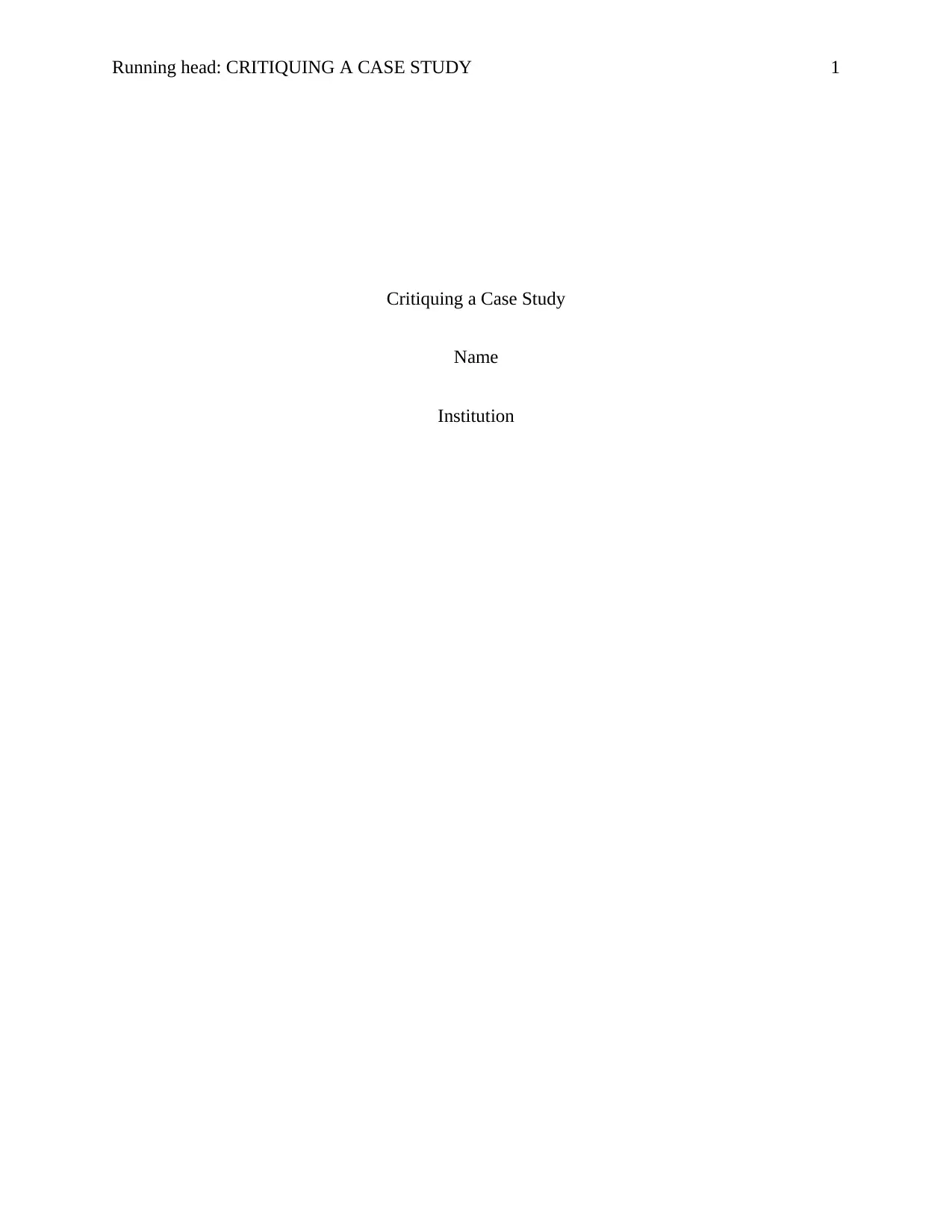
Running head: CRITIQUING A CASE STUDY 1
Critiquing a Case Study
Name
Institution
Critiquing a Case Study
Name
Institution
Paraphrase This Document
Need a fresh take? Get an instant paraphrase of this document with our AI Paraphraser
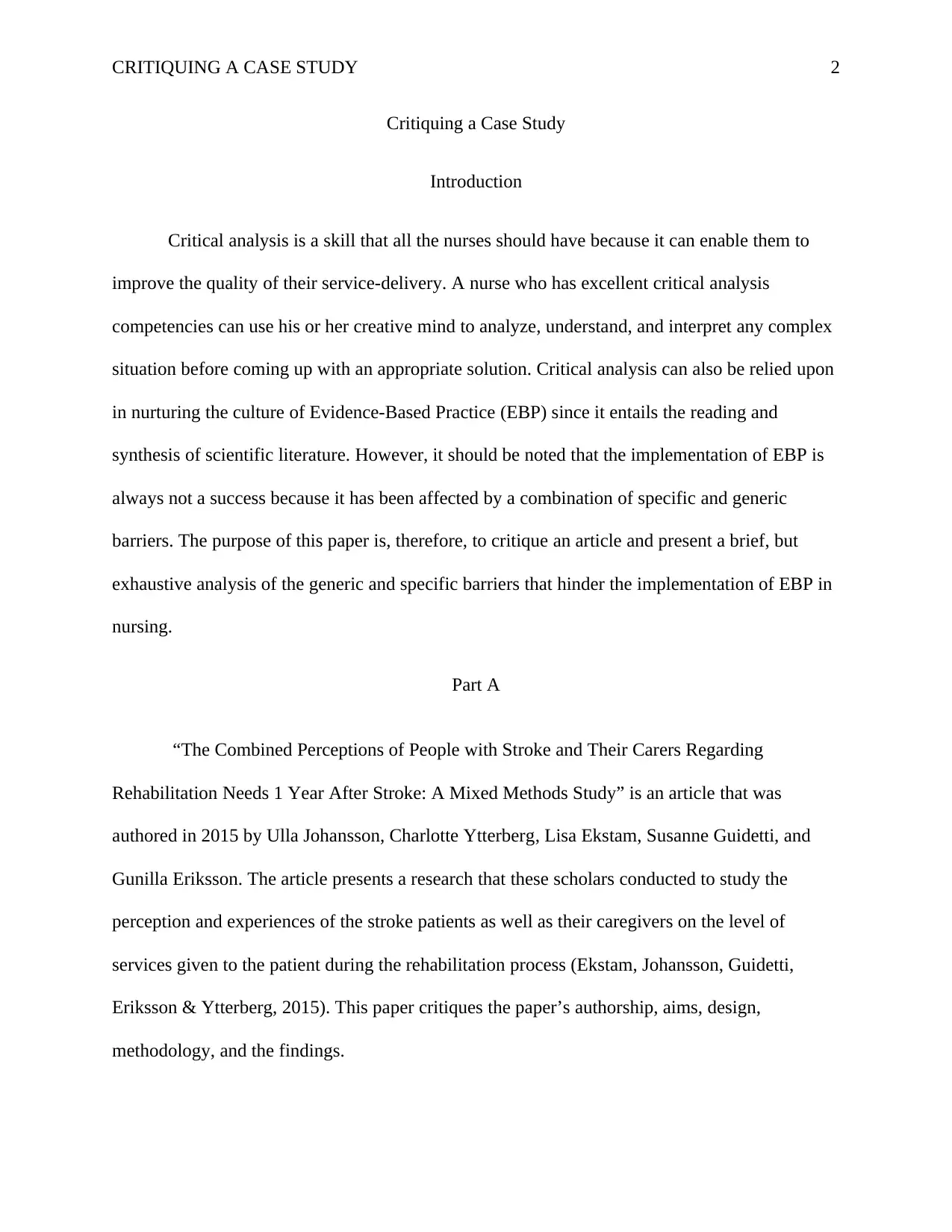
CRITIQUING A CASE STUDY 2
Critiquing a Case Study
Introduction
Critical analysis is a skill that all the nurses should have because it can enable them to
improve the quality of their service-delivery. A nurse who has excellent critical analysis
competencies can use his or her creative mind to analyze, understand, and interpret any complex
situation before coming up with an appropriate solution. Critical analysis can also be relied upon
in nurturing the culture of Evidence-Based Practice (EBP) since it entails the reading and
synthesis of scientific literature. However, it should be noted that the implementation of EBP is
always not a success because it has been affected by a combination of specific and generic
barriers. The purpose of this paper is, therefore, to critique an article and present a brief, but
exhaustive analysis of the generic and specific barriers that hinder the implementation of EBP in
nursing.
Part A
“The Combined Perceptions of People with Stroke and Their Carers Regarding
Rehabilitation Needs 1 Year After Stroke: A Mixed Methods Study” is an article that was
authored in 2015 by Ulla Johansson, Charlotte Ytterberg, Lisa Ekstam, Susanne Guidetti, and
Gunilla Eriksson. The article presents a research that these scholars conducted to study the
perception and experiences of the stroke patients as well as their caregivers on the level of
services given to the patient during the rehabilitation process (Ekstam, Johansson, Guidetti,
Eriksson & Ytterberg, 2015). This paper critiques the paper’s authorship, aims, design,
methodology, and the findings.
Critiquing a Case Study
Introduction
Critical analysis is a skill that all the nurses should have because it can enable them to
improve the quality of their service-delivery. A nurse who has excellent critical analysis
competencies can use his or her creative mind to analyze, understand, and interpret any complex
situation before coming up with an appropriate solution. Critical analysis can also be relied upon
in nurturing the culture of Evidence-Based Practice (EBP) since it entails the reading and
synthesis of scientific literature. However, it should be noted that the implementation of EBP is
always not a success because it has been affected by a combination of specific and generic
barriers. The purpose of this paper is, therefore, to critique an article and present a brief, but
exhaustive analysis of the generic and specific barriers that hinder the implementation of EBP in
nursing.
Part A
“The Combined Perceptions of People with Stroke and Their Carers Regarding
Rehabilitation Needs 1 Year After Stroke: A Mixed Methods Study” is an article that was
authored in 2015 by Ulla Johansson, Charlotte Ytterberg, Lisa Ekstam, Susanne Guidetti, and
Gunilla Eriksson. The article presents a research that these scholars conducted to study the
perception and experiences of the stroke patients as well as their caregivers on the level of
services given to the patient during the rehabilitation process (Ekstam, Johansson, Guidetti,
Eriksson & Ytterberg, 2015). This paper critiques the paper’s authorship, aims, design,
methodology, and the findings.
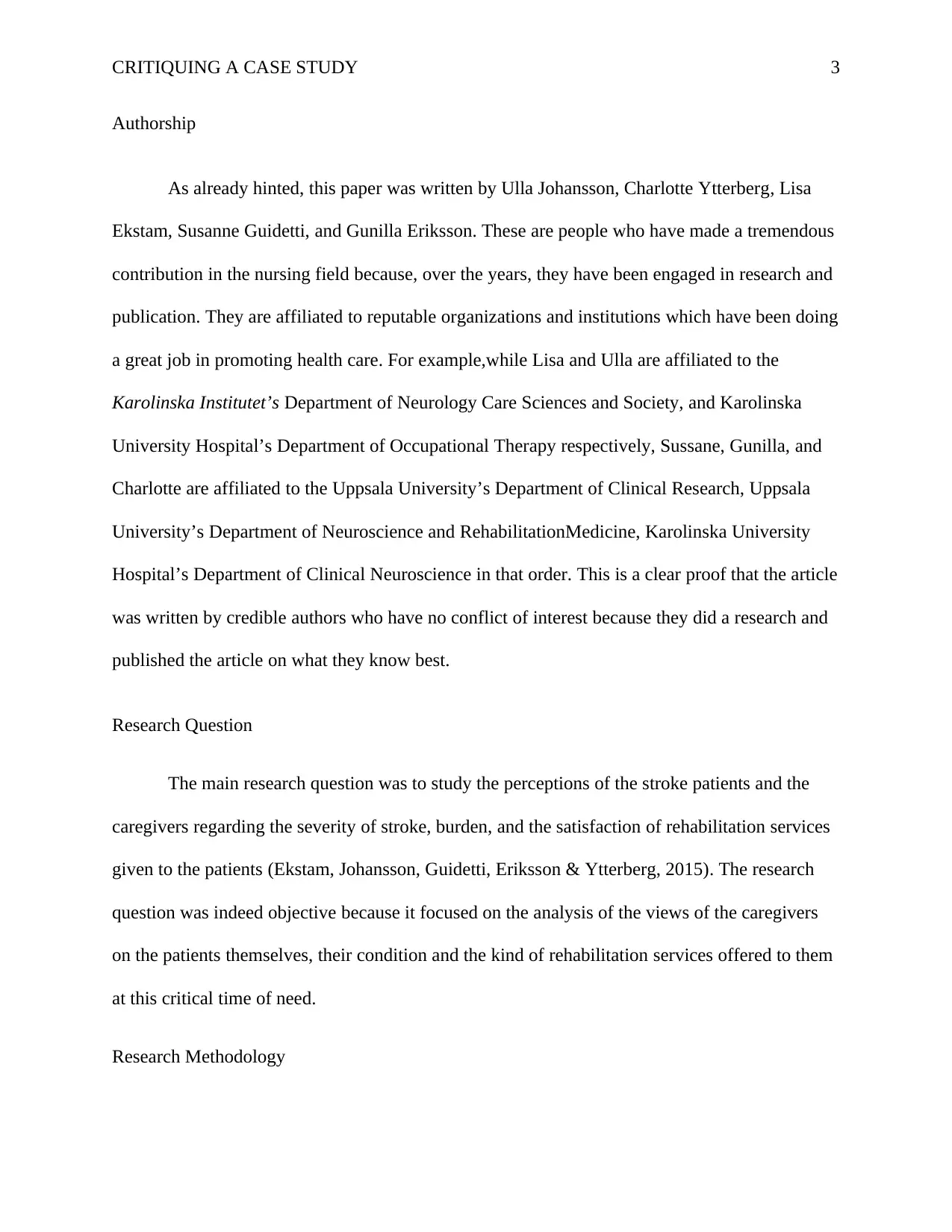
CRITIQUING A CASE STUDY 3
Authorship
As already hinted, this paper was written by Ulla Johansson, Charlotte Ytterberg, Lisa
Ekstam, Susanne Guidetti, and Gunilla Eriksson. These are people who have made a tremendous
contribution in the nursing field because, over the years, they have been engaged in research and
publication. They are affiliated to reputable organizations and institutions which have been doing
a great job in promoting health care. For example,while Lisa and Ulla are affiliated to the
Karolinska Institutet’s Department of Neurology Care Sciences and Society, and Karolinska
University Hospital’s Department of Occupational Therapy respectively, Sussane, Gunilla, and
Charlotte are affiliated to the Uppsala University’s Department of Clinical Research, Uppsala
University’s Department of Neuroscience and RehabilitationMedicine, Karolinska University
Hospital’s Department of Clinical Neuroscience in that order. This is a clear proof that the article
was written by credible authors who have no conflict of interest because they did a research and
published the article on what they know best.
Research Question
The main research question was to study the perceptions of the stroke patients and the
caregivers regarding the severity of stroke, burden, and the satisfaction of rehabilitation services
given to the patients (Ekstam, Johansson, Guidetti, Eriksson & Ytterberg, 2015). The research
question was indeed objective because it focused on the analysis of the views of the caregivers
on the patients themselves, their condition and the kind of rehabilitation services offered to them
at this critical time of need.
Research Methodology
Authorship
As already hinted, this paper was written by Ulla Johansson, Charlotte Ytterberg, Lisa
Ekstam, Susanne Guidetti, and Gunilla Eriksson. These are people who have made a tremendous
contribution in the nursing field because, over the years, they have been engaged in research and
publication. They are affiliated to reputable organizations and institutions which have been doing
a great job in promoting health care. For example,while Lisa and Ulla are affiliated to the
Karolinska Institutet’s Department of Neurology Care Sciences and Society, and Karolinska
University Hospital’s Department of Occupational Therapy respectively, Sussane, Gunilla, and
Charlotte are affiliated to the Uppsala University’s Department of Clinical Research, Uppsala
University’s Department of Neuroscience and RehabilitationMedicine, Karolinska University
Hospital’s Department of Clinical Neuroscience in that order. This is a clear proof that the article
was written by credible authors who have no conflict of interest because they did a research and
published the article on what they know best.
Research Question
The main research question was to study the perceptions of the stroke patients and the
caregivers regarding the severity of stroke, burden, and the satisfaction of rehabilitation services
given to the patients (Ekstam, Johansson, Guidetti, Eriksson & Ytterberg, 2015). The research
question was indeed objective because it focused on the analysis of the views of the caregivers
on the patients themselves, their condition and the kind of rehabilitation services offered to them
at this critical time of need.
Research Methodology
⊘ This is a preview!⊘
Do you want full access?
Subscribe today to unlock all pages.

Trusted by 1+ million students worldwide
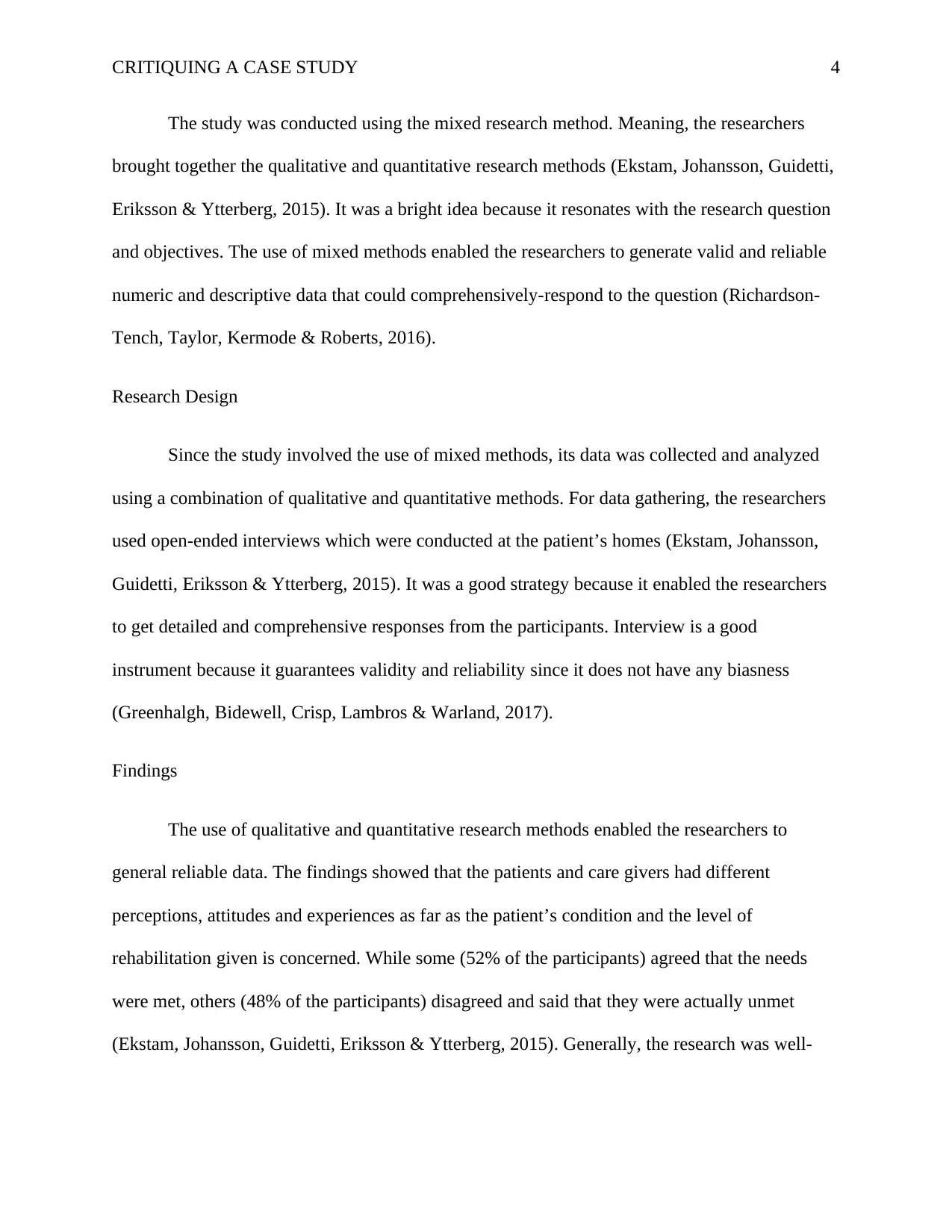
CRITIQUING A CASE STUDY 4
The study was conducted using the mixed research method. Meaning, the researchers
brought together the qualitative and quantitative research methods (Ekstam, Johansson, Guidetti,
Eriksson & Ytterberg, 2015). It was a bright idea because it resonates with the research question
and objectives. The use of mixed methods enabled the researchers to generate valid and reliable
numeric and descriptive data that could comprehensively-respond to the question (Richardson-
Tench, Taylor, Kermode & Roberts, 2016).
Research Design
Since the study involved the use of mixed methods, its data was collected and analyzed
using a combination of qualitative and quantitative methods. For data gathering, the researchers
used open-ended interviews which were conducted at the patient’s homes (Ekstam, Johansson,
Guidetti, Eriksson & Ytterberg, 2015). It was a good strategy because it enabled the researchers
to get detailed and comprehensive responses from the participants. Interview is a good
instrument because it guarantees validity and reliability since it does not have any biasness
(Greenhalgh, Bidewell, Crisp, Lambros & Warland, 2017).
Findings
The use of qualitative and quantitative research methods enabled the researchers to
general reliable data. The findings showed that the patients and care givers had different
perceptions, attitudes and experiences as far as the patient’s condition and the level of
rehabilitation given is concerned. While some (52% of the participants) agreed that the needs
were met, others (48% of the participants) disagreed and said that they were actually unmet
(Ekstam, Johansson, Guidetti, Eriksson & Ytterberg, 2015). Generally, the research was well-
The study was conducted using the mixed research method. Meaning, the researchers
brought together the qualitative and quantitative research methods (Ekstam, Johansson, Guidetti,
Eriksson & Ytterberg, 2015). It was a bright idea because it resonates with the research question
and objectives. The use of mixed methods enabled the researchers to generate valid and reliable
numeric and descriptive data that could comprehensively-respond to the question (Richardson-
Tench, Taylor, Kermode & Roberts, 2016).
Research Design
Since the study involved the use of mixed methods, its data was collected and analyzed
using a combination of qualitative and quantitative methods. For data gathering, the researchers
used open-ended interviews which were conducted at the patient’s homes (Ekstam, Johansson,
Guidetti, Eriksson & Ytterberg, 2015). It was a good strategy because it enabled the researchers
to get detailed and comprehensive responses from the participants. Interview is a good
instrument because it guarantees validity and reliability since it does not have any biasness
(Greenhalgh, Bidewell, Crisp, Lambros & Warland, 2017).
Findings
The use of qualitative and quantitative research methods enabled the researchers to
general reliable data. The findings showed that the patients and care givers had different
perceptions, attitudes and experiences as far as the patient’s condition and the level of
rehabilitation given is concerned. While some (52% of the participants) agreed that the needs
were met, others (48% of the participants) disagreed and said that they were actually unmet
(Ekstam, Johansson, Guidetti, Eriksson & Ytterberg, 2015). Generally, the research was well-
Paraphrase This Document
Need a fresh take? Get an instant paraphrase of this document with our AI Paraphraser
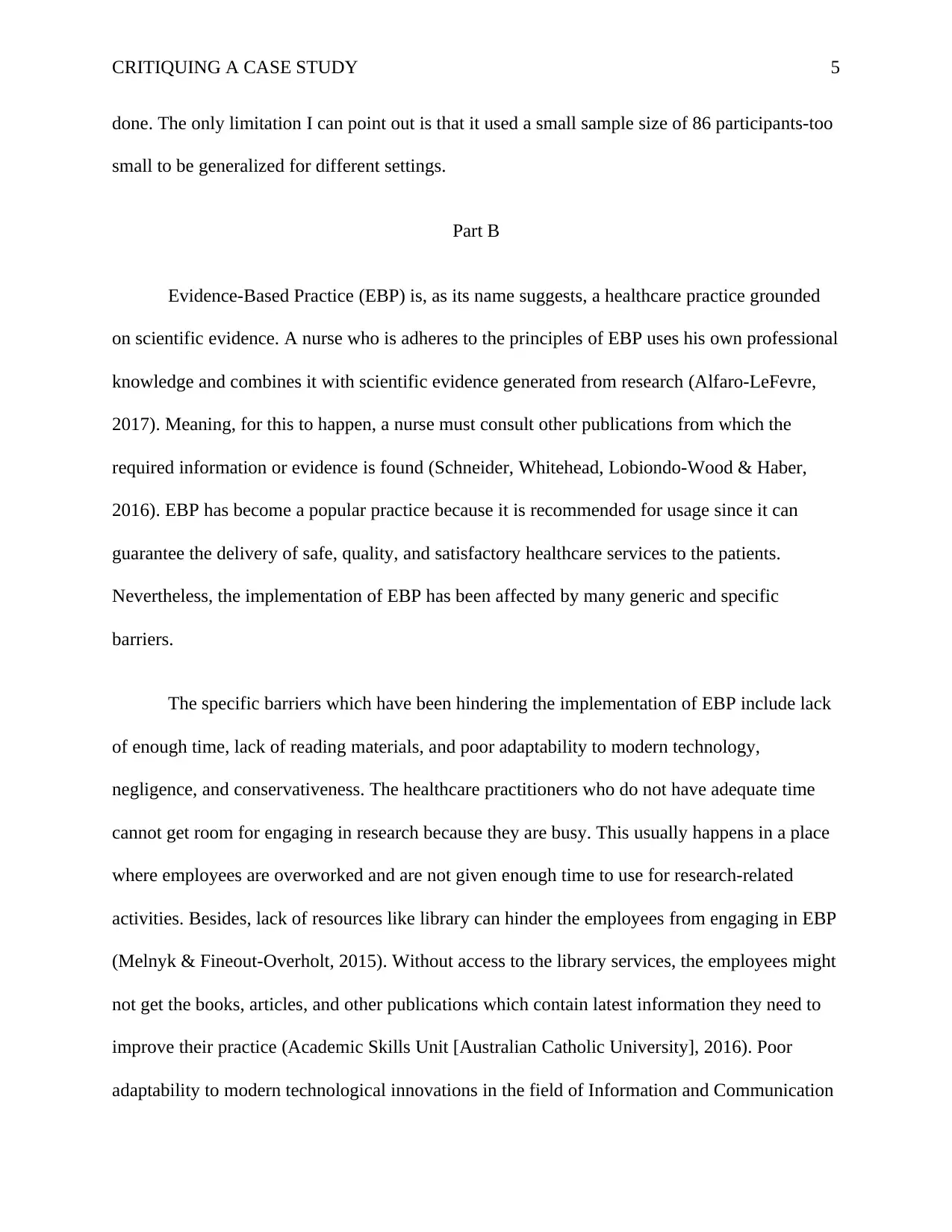
CRITIQUING A CASE STUDY 5
done. The only limitation I can point out is that it used a small sample size of 86 participants-too
small to be generalized for different settings.
Part B
Evidence-Based Practice (EBP) is, as its name suggests, a healthcare practice grounded
on scientific evidence. A nurse who is adheres to the principles of EBP uses his own professional
knowledge and combines it with scientific evidence generated from research (Alfaro-LeFevre,
2017). Meaning, for this to happen, a nurse must consult other publications from which the
required information or evidence is found (Schneider, Whitehead, Lobiondo-Wood & Haber,
2016). EBP has become a popular practice because it is recommended for usage since it can
guarantee the delivery of safe, quality, and satisfactory healthcare services to the patients.
Nevertheless, the implementation of EBP has been affected by many generic and specific
barriers.
The specific barriers which have been hindering the implementation of EBP include lack
of enough time, lack of reading materials, and poor adaptability to modern technology,
negligence, and conservativeness. The healthcare practitioners who do not have adequate time
cannot get room for engaging in research because they are busy. This usually happens in a place
where employees are overworked and are not given enough time to use for research-related
activities. Besides, lack of resources like library can hinder the employees from engaging in EBP
(Melnyk & Fineout-Overholt, 2015). Without access to the library services, the employees might
not get the books, articles, and other publications which contain latest information they need to
improve their practice (Academic Skills Unit [Australian Catholic University], 2016). Poor
adaptability to modern technological innovations in the field of Information and Communication
done. The only limitation I can point out is that it used a small sample size of 86 participants-too
small to be generalized for different settings.
Part B
Evidence-Based Practice (EBP) is, as its name suggests, a healthcare practice grounded
on scientific evidence. A nurse who is adheres to the principles of EBP uses his own professional
knowledge and combines it with scientific evidence generated from research (Alfaro-LeFevre,
2017). Meaning, for this to happen, a nurse must consult other publications from which the
required information or evidence is found (Schneider, Whitehead, Lobiondo-Wood & Haber,
2016). EBP has become a popular practice because it is recommended for usage since it can
guarantee the delivery of safe, quality, and satisfactory healthcare services to the patients.
Nevertheless, the implementation of EBP has been affected by many generic and specific
barriers.
The specific barriers which have been hindering the implementation of EBP include lack
of enough time, lack of reading materials, and poor adaptability to modern technology,
negligence, and conservativeness. The healthcare practitioners who do not have adequate time
cannot get room for engaging in research because they are busy. This usually happens in a place
where employees are overworked and are not given enough time to use for research-related
activities. Besides, lack of resources like library can hinder the employees from engaging in EBP
(Melnyk & Fineout-Overholt, 2015). Without access to the library services, the employees might
not get the books, articles, and other publications which contain latest information they need to
improve their practice (Academic Skills Unit [Australian Catholic University], 2016). Poor
adaptability to modern technological innovations in the field of Information and Communication
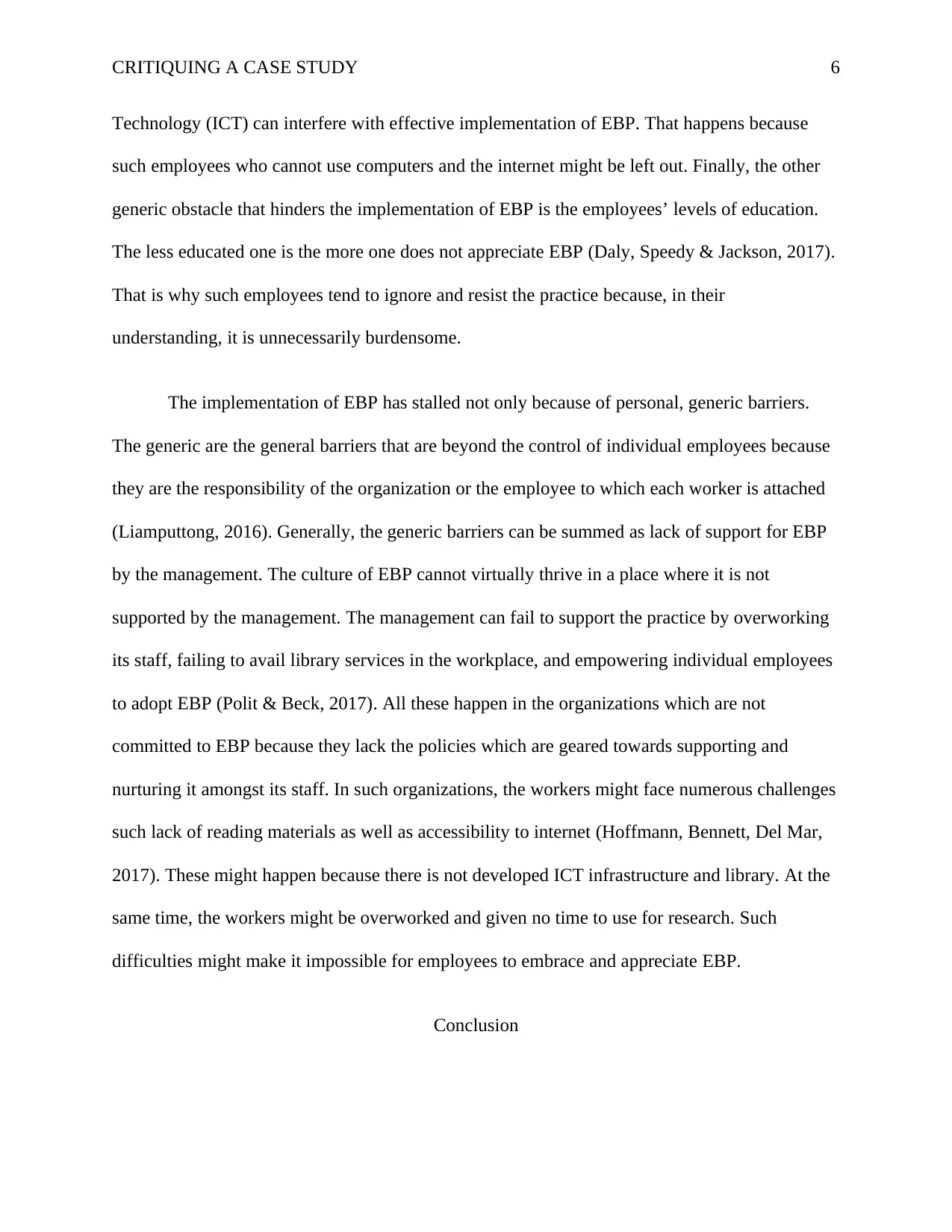
CRITIQUING A CASE STUDY 6
Technology (ICT) can interfere with effective implementation of EBP. That happens because
such employees who cannot use computers and the internet might be left out. Finally, the other
generic obstacle that hinders the implementation of EBP is the employees’ levels of education.
The less educated one is the more one does not appreciate EBP (Daly, Speedy & Jackson, 2017).
That is why such employees tend to ignore and resist the practice because, in their
understanding, it is unnecessarily burdensome.
The implementation of EBP has stalled not only because of personal, generic barriers.
The generic are the general barriers that are beyond the control of individual employees because
they are the responsibility of the organization or the employee to which each worker is attached
(Liamputtong, 2016). Generally, the generic barriers can be summed as lack of support for EBP
by the management. The culture of EBP cannot virtually thrive in a place where it is not
supported by the management. The management can fail to support the practice by overworking
its staff, failing to avail library services in the workplace, and empowering individual employees
to adopt EBP (Polit & Beck, 2017). All these happen in the organizations which are not
committed to EBP because they lack the policies which are geared towards supporting and
nurturing it amongst its staff. In such organizations, the workers might face numerous challenges
such lack of reading materials as well as accessibility to internet (Hoffmann, Bennett, Del Mar,
2017). These might happen because there is not developed ICT infrastructure and library. At the
same time, the workers might be overworked and given no time to use for research. Such
difficulties might make it impossible for employees to embrace and appreciate EBP.
Conclusion
Technology (ICT) can interfere with effective implementation of EBP. That happens because
such employees who cannot use computers and the internet might be left out. Finally, the other
generic obstacle that hinders the implementation of EBP is the employees’ levels of education.
The less educated one is the more one does not appreciate EBP (Daly, Speedy & Jackson, 2017).
That is why such employees tend to ignore and resist the practice because, in their
understanding, it is unnecessarily burdensome.
The implementation of EBP has stalled not only because of personal, generic barriers.
The generic are the general barriers that are beyond the control of individual employees because
they are the responsibility of the organization or the employee to which each worker is attached
(Liamputtong, 2016). Generally, the generic barriers can be summed as lack of support for EBP
by the management. The culture of EBP cannot virtually thrive in a place where it is not
supported by the management. The management can fail to support the practice by overworking
its staff, failing to avail library services in the workplace, and empowering individual employees
to adopt EBP (Polit & Beck, 2017). All these happen in the organizations which are not
committed to EBP because they lack the policies which are geared towards supporting and
nurturing it amongst its staff. In such organizations, the workers might face numerous challenges
such lack of reading materials as well as accessibility to internet (Hoffmann, Bennett, Del Mar,
2017). These might happen because there is not developed ICT infrastructure and library. At the
same time, the workers might be overworked and given no time to use for research. Such
difficulties might make it impossible for employees to embrace and appreciate EBP.
Conclusion
⊘ This is a preview!⊘
Do you want full access?
Subscribe today to unlock all pages.

Trusted by 1+ million students worldwide
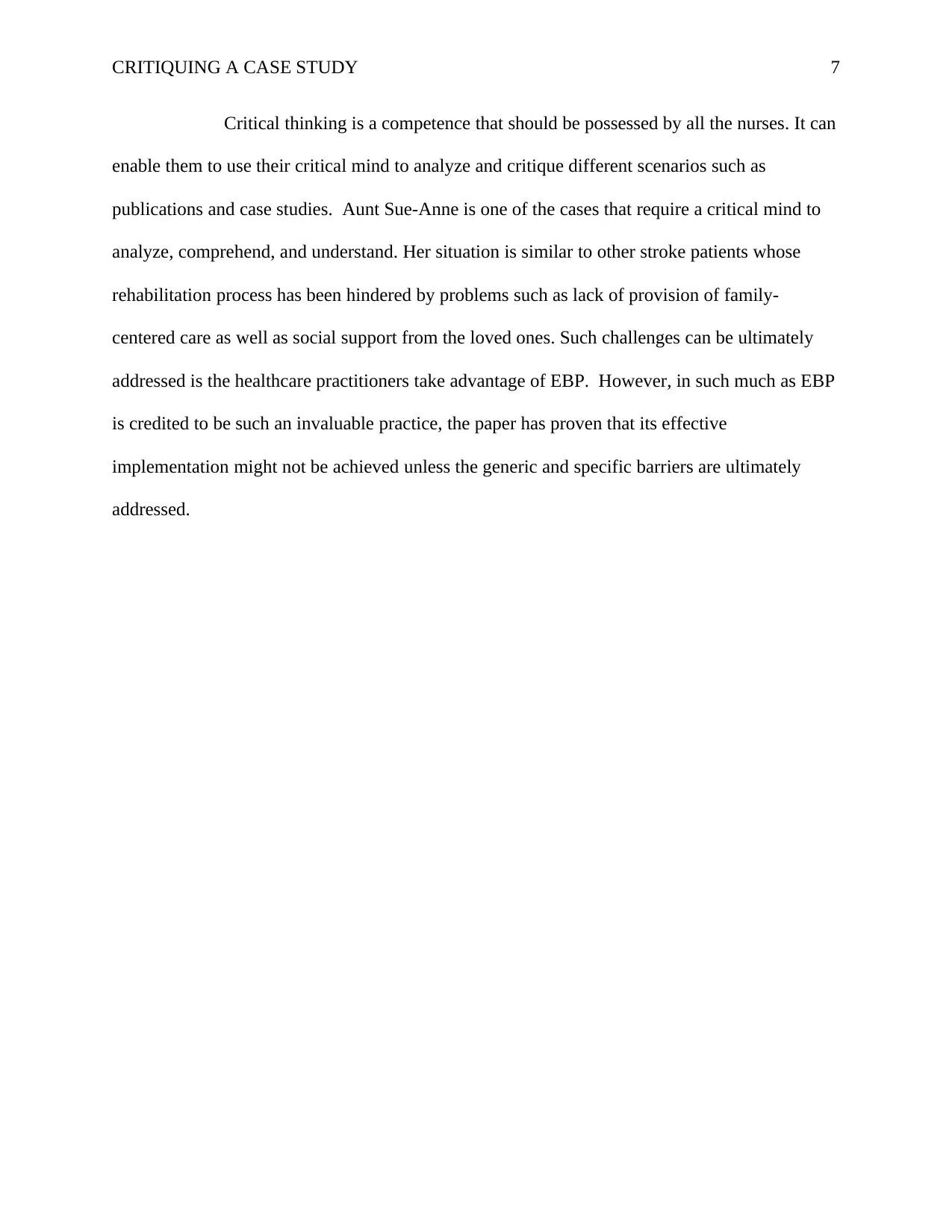
CRITIQUING A CASE STUDY 7
Critical thinking is a competence that should be possessed by all the nurses. It can
enable them to use their critical mind to analyze and critique different scenarios such as
publications and case studies. Aunt Sue-Anne is one of the cases that require a critical mind to
analyze, comprehend, and understand. Her situation is similar to other stroke patients whose
rehabilitation process has been hindered by problems such as lack of provision of family-
centered care as well as social support from the loved ones. Such challenges can be ultimately
addressed is the healthcare practitioners take advantage of EBP. However, in such much as EBP
is credited to be such an invaluable practice, the paper has proven that its effective
implementation might not be achieved unless the generic and specific barriers are ultimately
addressed.
Critical thinking is a competence that should be possessed by all the nurses. It can
enable them to use their critical mind to analyze and critique different scenarios such as
publications and case studies. Aunt Sue-Anne is one of the cases that require a critical mind to
analyze, comprehend, and understand. Her situation is similar to other stroke patients whose
rehabilitation process has been hindered by problems such as lack of provision of family-
centered care as well as social support from the loved ones. Such challenges can be ultimately
addressed is the healthcare practitioners take advantage of EBP. However, in such much as EBP
is credited to be such an invaluable practice, the paper has proven that its effective
implementation might not be achieved unless the generic and specific barriers are ultimately
addressed.
Paraphrase This Document
Need a fresh take? Get an instant paraphrase of this document with our AI Paraphraser
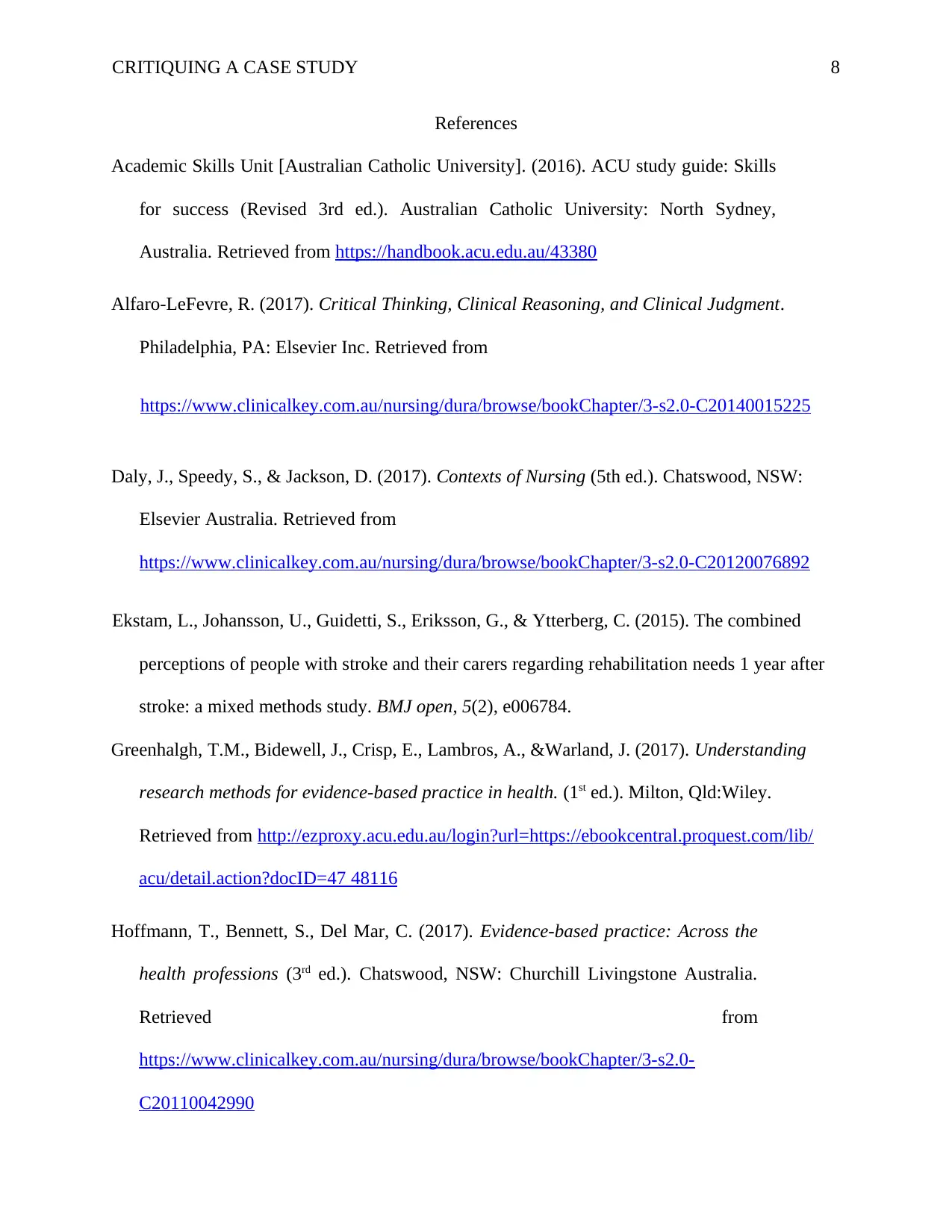
CRITIQUING A CASE STUDY 8
References
Academic Skills Unit [Australian Catholic University]. (2016). ACU study guide: Skills
for success (Revised 3rd ed.). Australian Catholic University: North Sydney,
Australia. Retrieved from https://handbook.acu.edu.au/43380
Alfaro-LeFevre, R. (2017). Critical Thinking, Clinical Reasoning, and Clinical Judgment.
Philadelphia, PA: Elsevier Inc. Retrieved from
https://www.clinicalkey.com.au/nursing/dura/browse/bookChapter/3-s2.0-C20140015225
Daly, J., Speedy, S., & Jackson, D. (2017). Contexts of Nursing (5th ed.). Chatswood, NSW:
Elsevier Australia. Retrieved from
https://www.clinicalkey.com.au/nursing/dura/browse/bookChapter/3-s2.0-C20120076892
Ekstam, L., Johansson, U., Guidetti, S., Eriksson, G., & Ytterberg, C. (2015). The combined
perceptions of people with stroke and their carers regarding rehabilitation needs 1 year after
stroke: a mixed methods study. BMJ open, 5(2), e006784.
Greenhalgh, T.M., Bidewell, J., Crisp, E., Lambros, A., &Warland, J. (2017). Understanding
research methods for evidence-based practice in health. (1st ed.). Milton, Qld:Wiley.
Retrieved from http://ezproxy.acu.edu.au/login?url=https://ebookcentral.proquest.com/lib/
acu/detail.action?docID=47 48116
Hoffmann, T., Bennett, S., Del Mar, C. (2017). Evidence-based practice: Across the
health professions (3rd ed.). Chatswood, NSW: Churchill Livingstone Australia.
Retrieved from
https://www.clinicalkey.com.au/nursing/dura/browse/bookChapter/3-s2.0-
C20110042990
References
Academic Skills Unit [Australian Catholic University]. (2016). ACU study guide: Skills
for success (Revised 3rd ed.). Australian Catholic University: North Sydney,
Australia. Retrieved from https://handbook.acu.edu.au/43380
Alfaro-LeFevre, R. (2017). Critical Thinking, Clinical Reasoning, and Clinical Judgment.
Philadelphia, PA: Elsevier Inc. Retrieved from
https://www.clinicalkey.com.au/nursing/dura/browse/bookChapter/3-s2.0-C20140015225
Daly, J., Speedy, S., & Jackson, D. (2017). Contexts of Nursing (5th ed.). Chatswood, NSW:
Elsevier Australia. Retrieved from
https://www.clinicalkey.com.au/nursing/dura/browse/bookChapter/3-s2.0-C20120076892
Ekstam, L., Johansson, U., Guidetti, S., Eriksson, G., & Ytterberg, C. (2015). The combined
perceptions of people with stroke and their carers regarding rehabilitation needs 1 year after
stroke: a mixed methods study. BMJ open, 5(2), e006784.
Greenhalgh, T.M., Bidewell, J., Crisp, E., Lambros, A., &Warland, J. (2017). Understanding
research methods for evidence-based practice in health. (1st ed.). Milton, Qld:Wiley.
Retrieved from http://ezproxy.acu.edu.au/login?url=https://ebookcentral.proquest.com/lib/
acu/detail.action?docID=47 48116
Hoffmann, T., Bennett, S., Del Mar, C. (2017). Evidence-based practice: Across the
health professions (3rd ed.). Chatswood, NSW: Churchill Livingstone Australia.
Retrieved from
https://www.clinicalkey.com.au/nursing/dura/browse/bookChapter/3-s2.0-
C20110042990
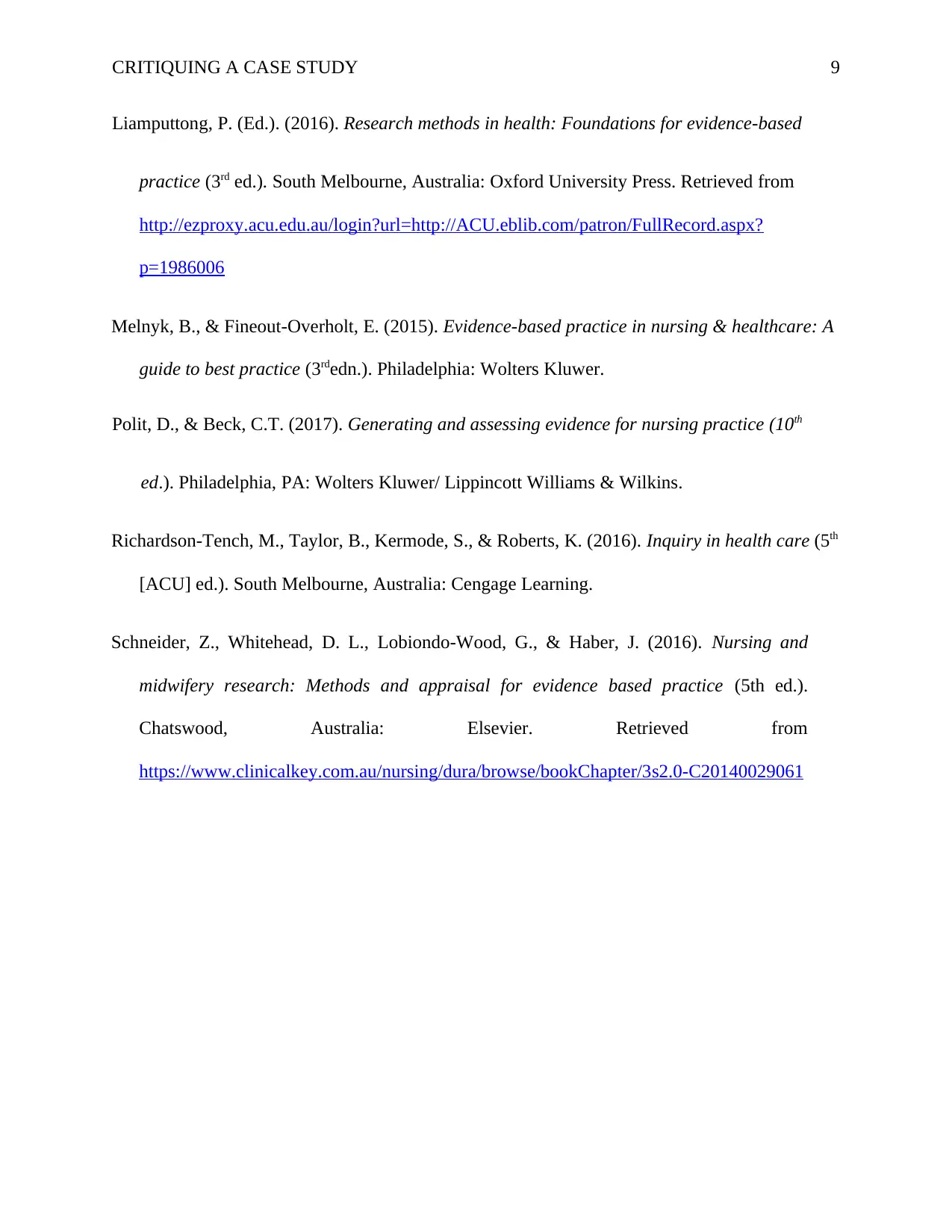
CRITIQUING A CASE STUDY 9
Liamputtong, P. (Ed.). (2016). Research methods in health: Foundations for evidence-based
practice (3rd ed.). South Melbourne, Australia: Oxford University Press. Retrieved from
http://ezproxy.acu.edu.au/login?url=http://ACU.eblib.com/patron/FullRecord.aspx?
p=1986006
Melnyk, B., & Fineout-Overholt, E. (2015). Evidence-based practice in nursing & healthcare: A
guide to best practice (3rdedn.). Philadelphia: Wolters Kluwer.
Polit, D., & Beck, C.T. (2017). Generating and assessing evidence for nursing practice (10th
ed.). Philadelphia, PA: Wolters Kluwer/ Lippincott Williams & Wilkins.
Richardson-Tench, M., Taylor, B., Kermode, S., & Roberts, K. (2016). Inquiry in health care (5th
[ACU] ed.). South Melbourne, Australia: Cengage Learning.
Schneider, Z., Whitehead, D. L., Lobiondo-Wood, G., & Haber, J. (2016). Nursing and
midwifery research: Methods and appraisal for evidence based practice (5th ed.).
Chatswood, Australia: Elsevier. Retrieved from
https://www.clinicalkey.com.au/nursing/dura/browse/bookChapter/3s2.0-C20140029061
Liamputtong, P. (Ed.). (2016). Research methods in health: Foundations for evidence-based
practice (3rd ed.). South Melbourne, Australia: Oxford University Press. Retrieved from
http://ezproxy.acu.edu.au/login?url=http://ACU.eblib.com/patron/FullRecord.aspx?
p=1986006
Melnyk, B., & Fineout-Overholt, E. (2015). Evidence-based practice in nursing & healthcare: A
guide to best practice (3rdedn.). Philadelphia: Wolters Kluwer.
Polit, D., & Beck, C.T. (2017). Generating and assessing evidence for nursing practice (10th
ed.). Philadelphia, PA: Wolters Kluwer/ Lippincott Williams & Wilkins.
Richardson-Tench, M., Taylor, B., Kermode, S., & Roberts, K. (2016). Inquiry in health care (5th
[ACU] ed.). South Melbourne, Australia: Cengage Learning.
Schneider, Z., Whitehead, D. L., Lobiondo-Wood, G., & Haber, J. (2016). Nursing and
midwifery research: Methods and appraisal for evidence based practice (5th ed.).
Chatswood, Australia: Elsevier. Retrieved from
https://www.clinicalkey.com.au/nursing/dura/browse/bookChapter/3s2.0-C20140029061
⊘ This is a preview!⊘
Do you want full access?
Subscribe today to unlock all pages.

Trusted by 1+ million students worldwide
1 out of 9
Related Documents
Your All-in-One AI-Powered Toolkit for Academic Success.
+13062052269
info@desklib.com
Available 24*7 on WhatsApp / Email
![[object Object]](/_next/static/media/star-bottom.7253800d.svg)
Unlock your academic potential
Copyright © 2020–2025 A2Z Services. All Rights Reserved. Developed and managed by ZUCOL.




